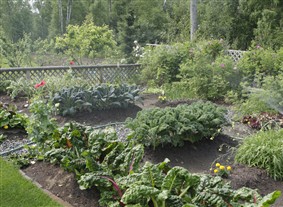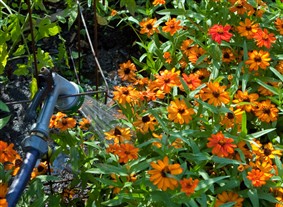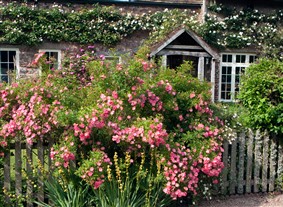An Alaskan Kitchen Garden
Views: 5280

I had the great fortune to speak at the 2009 Alaska Garden and Art Festival in Palmer, Alaska last Saturday. I also had the great fortune to see some great Alaskan gardens. It’s a beautiful state! I am traveling and soaking up the beauty and views of this great state.
Really, my zone 5 Ohio garden does seem balmy in comparison. The area around Anchorage is a climate zone 4, but that rapidly changes as you move away from the coast or increase in elevation.
I spoke with some gardeners that are climate zone 2. Right now strawberries are just beginning to ripen. Peonies are just beginning to bloom in the middle of July. (My peonies finished blooming six weeks ago.) Someone mentioned there is a demand for Alaskan fresh cut peonies in the lower 48 for this reason. I can only imagine the flowers are cut in the bud stage and shipped chilled, so florist bouquets are filled with the fragrant blooms when no one else has them.
Alaskan Vegetable Garden
Chives, peas, spinach, kale, broccoli, and lettuce look great now. These cool season varieties will continue to thrive all summer. What is difficult to grow even with over 20 hours of sunlight a day are tomatoes, cucumbers, and peppers. You need a greenhouse for these. The growing season is just too short and the days are too cool.
I keep thinking of the importance of microclimates and am reminded of a famous garden where the climate was pushed to produce fruits and vegetables out of season. The kitchen garden at Versailles was a technological marvel of the 1600s. La Quintinie, a lawyer turned kitchen garden designer, was able to send to the table of Louis XIV asparagus and sorrel in December; radishes, lettuces, and mushrooms in January; cauliflower in March; strawberries early in April; peas in May; and melons in June.
Creating Microclimates
So the location of the kitchen garden becomes critical. White spruce planted on the north side to protect from wind could make a difference. Buildings and walls surrounding the garden could make a difference. Glass cloches in the garden could make a difference. Stone walkways that store and reflect heat could make a difference. Study your property—often there are pockets of warmth.
The goal in cold climate gardening is to create a microclimate and push your gardening zone. With a little glass and protection you will be able to grow basil.
The photo was taken at Doug and Florene Carneys Snowfire Garden in Wasilla. They grow tomatoes and cucumbers in their greenhouse. They start artichokes and beans in the greenhouse and then transplant them to the garden. Their cold climate kitchen garden is bursting with honey berries, raspberries, strawberries, fruit trees, herbs, flowers and an abundance of greens.
Meet Jennifer Bartley
Jennifer Bartley grew up on a ravine near an ancient Indian mound. She remembers spending glorious childhood days picking wildflowers and playing in an old,…
Jennifer's Recent Posts

Hand Watering the Kitchen Garden








